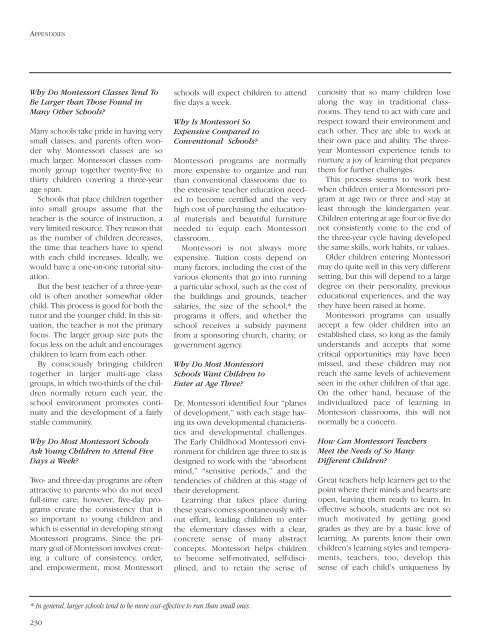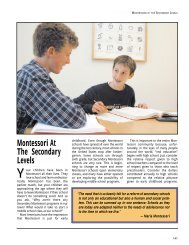Tim Seldin & Paul Epstein Ph.D. An Education for Life
Tim Seldin & Paul Epstein Ph.D. An Education for Life
Tim Seldin & Paul Epstein Ph.D. An Education for Life
You also want an ePaper? Increase the reach of your titles
YUMPU automatically turns print PDFs into web optimized ePapers that Google loves.
APPENDIXES<br />
Why Do Montessori Classes Tend To<br />
Be Larger than Those Found in<br />
Many Other Schools?<br />
Many schools take pride in having very<br />
small classes, and parents often wonder<br />
why Montessori classes are so<br />
much larger. Montessori classes commonly<br />
group together twenty-five to<br />
thirty children covering a three-year<br />
age span.<br />
Schools that place children together<br />
into small groups assume that the<br />
teacher is the source of instruction, a<br />
very limited resource. They reason that<br />
as the number of children decreases,<br />
the time that teachers have to spend<br />
with each child increases. Ideally, we<br />
would have a one-on-one tutorial situation.<br />
But the best teacher of a three-yearold<br />
is often another somewhat older<br />
child. This process is good <strong>for</strong> both the<br />
tutor and the younger child. In this situation,<br />
the teacher is not the primary<br />
focus. The larger group size puts the<br />
focus less on the adult and encourages<br />
children to learn from each other.<br />
By consciously bringing children<br />
together in larger multi-age class<br />
groups, in which two-thirds of the children<br />
normally return each year, the<br />
school environment promotes continuity<br />
and the development of a fairly<br />
stable community.<br />
Why Do Most Montessori Schools<br />
Ask Young Children to Attend Five<br />
Days a Week?<br />
Two- and three-day programs are often<br />
attractive to parents who do not need<br />
full-time care; however, five-day programs<br />
create the consistency that is<br />
so important to young children and<br />
which is essential in developing strong<br />
Montessori programs. Since the primary<br />
goal of Montessori involves creating<br />
a culture of consistency, order,<br />
and empowerment, most Montessori<br />
230<br />
schools will expect children to attend<br />
five days a week.<br />
Why Is Montessori So<br />
Expensive Compared to<br />
Conventional Schools?<br />
Montessori programs are normally<br />
more expensive to organize and run<br />
than conventional classrooms due to<br />
the extensive teacher education needed<br />
to become certified and the very<br />
high cost of purchasing the educational<br />
materials and beautiful furniture<br />
needed to equip each Montessori<br />
classroom.<br />
Montessori is not always more<br />
expensive. Tuition costs depend on<br />
many factors, including the cost of the<br />
various elements that go into running<br />
a particular school, such as the cost of<br />
the buildings and grounds, teacher<br />
salaries, the size of the school,* the<br />
programs it offers, and whether the<br />
school receives a subsidy payment<br />
from a sponsoring church, charity, or<br />
government agency.<br />
Why Do Most Montessori<br />
Schools Want Children to<br />
Enter at Age Three?<br />
Dr. Montessori identified four “planes<br />
of development,” with each stage having<br />
its own developmental characteristics<br />
and developmental challenges.<br />
The Early Childhood Montessori environment<br />
<strong>for</strong> children age three to six is<br />
designed to work with the “absorbent<br />
mind,” “sensitive periods,” and the<br />
tendencies of children at this stage of<br />
their development.<br />
Learning that takes place during<br />
these years comes spontaneously without<br />
ef<strong>for</strong>t, leading children to enter<br />
the elementary classes with a clear,<br />
concrete sense of many abstract<br />
concepts. Montessori helps children<br />
to become self-motivated, self-disciplined,<br />
and to retain the sense of<br />
* In general, larger schools tend to be more cost-effective to run than small ones.<br />
curiosity that so many children lose<br />
along the way in traditional classrooms.<br />
They tend to act with care and<br />
respect toward their environment and<br />
each other. They are able to work at<br />
their own pace and ability. The threeyear<br />
Montessori experience tends to<br />
nurture a joy of learning that prepares<br />
them <strong>for</strong> further challenges.<br />
This process seems to work best<br />
when children enter a Montessori program<br />
at age two or three and stay at<br />
least through the kindergarten year.<br />
Children entering at age four or five do<br />
not consistently come to the end of<br />
the three-year cycle having developed<br />
the same skills, work habits, or values.<br />
Older children entering Montessori<br />
may do quite well in this very different<br />
setting, but this will depend to a large<br />
degree on their personality, previous<br />
educational experiences, and the way<br />
they have been raised at home.<br />
Montessori programs can usually<br />
accept a few older children into an<br />
established class, so long as the family<br />
understands and accepts that some<br />
critical opportunities may have been<br />
missed, and these children may not<br />
reach the same levels of achievement<br />
seen in the other children of that age.<br />
On the other hand, because of the<br />
individualized pace of learning in<br />
Montessori classrooms, this will not<br />
normally be a concern.<br />
How Can Montessori Teachers<br />
Meet the Needs of So Many<br />
Different Children?<br />
Great teachers help learners get to the<br />
point where their minds and hearts are<br />
open, leaving them ready to learn. In<br />
effective schools, students are not so<br />
much motivated by getting good<br />
grades as they are by a basic love of<br />
learning. As parents know their own<br />
children’s learning styles and temperaments,<br />
teachers, too, develop this<br />
sense of each child’s uniqueness by




